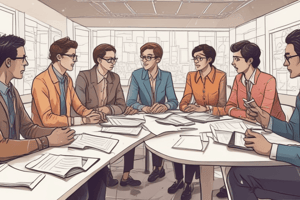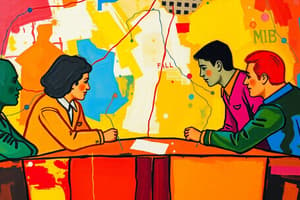Podcast
Questions and Answers
What is role overload?
What is role overload?
- When too much is expected of someone (correct)
- When individuals feel they are not contributing
- When people are unsure about their roles
- When expectations are unclear
Role ambiguity occurs when individuals are clear about their roles.
Role ambiguity occurs when individuals are clear about their roles.
False (B)
What is deviant workplace behavior (DWB)?
What is deviant workplace behavior (DWB)?
Voluntary behavior that violates significant organizational norms.
Norms are standards of behavior shared by a ________.
Norms are standards of behavior shared by a ________.
Match the following types of norms with their descriptions:
Match the following types of norms with their descriptions:
What is a primary characteristic that differentiates a team from a group?
What is a primary characteristic that differentiates a team from a group?
Efficiency and effectiveness are the same concept in teamwork.
Efficiency and effectiveness are the same concept in teamwork.
List one reason why teamwork can be problematic.
List one reason why teamwork can be problematic.
A situation in which an individual finds it difficult to comply with conflicting role expectations is called _____ conflict.
A situation in which an individual finds it difficult to comply with conflicting role expectations is called _____ conflict.
Match the type of teams with their characteristics:
Match the type of teams with their characteristics:
When is it better to use individuals instead of teams?
When is it better to use individuals instead of teams?
Increased productivity is achieved only through effectiveness.
Increased productivity is achieved only through effectiveness.
What is the end goal of a team compared to a group?
What is the end goal of a team compared to a group?
What is a key factor for team performance during the first meeting?
What is a key factor for team performance during the first meeting?
Teams always perform better with larger group sizes.
Teams always perform better with larger group sizes.
What is one advantage of team diversity?
What is one advantage of team diversity?
High-performing teams benefit from __________ safety and clear expectations.
High-performing teams benefit from __________ safety and clear expectations.
Match the following characteristics with their corresponding benefits of effective teams:
Match the following characteristics with their corresponding benefits of effective teams:
What term describes the tendency for individuals to expend less effort when working in teams?
What term describes the tendency for individuals to expend less effort when working in teams?
Conscientious individuals do not significantly impact team performance.
Conscientious individuals do not significantly impact team performance.
Name one characteristic of effective teams as described by Hackman.
Name one characteristic of effective teams as described by Hackman.
What is a key characteristic of strong teams?
What is a key characteristic of strong teams?
Diversity in strong teams includes aspects such as age, gender, and education.
Diversity in strong teams includes aspects such as age, gender, and education.
What does 'team cohesion' refer to?
What does 'team cohesion' refer to?
Strong teams require a common _____ and purpose.
Strong teams require a common _____ and purpose.
Match the following team roles with their descriptions:
Match the following team roles with their descriptions:
Flashcards are hidden until you start studying
Study Notes
Groups and Teams
- Teams are a small group of people with a common objective who are accountable to one another.
- Groups may have a common relationship or objective.
- Efficiency refers to achieving the same output with fewer inputs.
- Effectiveness refers to successfully achieving goals.
- Increased efficiency and/or effectiveness equate to increased productivity.
- Teams can be more flexible and motivational but can also decrease efficiency due to time and resources.
- When tasks require multiple skills, judgment, and expertise, teams are often more effective.
- When an individual can perform work alone, or a quick decision is needed, an individual is often better.
- Tasks that are interdependent benefit from teams.
- A role refers to a set of expected behaviors of a person in a given position.
- People have different roles both at work and outside of work.
- Role conflict occurs when complying with one role requirement makes it difficult to comply with another.
- Role ambiguity occurs when people are unclear about their role.
- Role overload occurs when too much is expected of someone.
- Role underload happens when too little is expected of a person.
- Norms are standards of behavior shared by a group.
- Norms can include performance standards, appearance standards, social arrangement standards, and allocation of resources standards.
- Norms develop through explicit statements, critical events, initial patterns of behavior and carry-over behavior.
- Norms can benefit a group by increasing predictability, reducing embarrassing situations, and strengthening group identity.
- Groups should be mindful of pressure to conform.
- Deviant workplace behavior (DWB) refers to voluntary behavior that violates organizational norms.
- DWB can also be called antisocial behavior or workplace incivility.
- DWB can result in decreased productivity and organizational performance.
- Important norms for teams include how to manage conflict, decision-making, communication, meetings, and responsibility and accountability.
Group Development Models
- The Five-stage model of groups proposes non-linear movement and variable performance with potential benefits of conflict.
- The Punctuated Equilibrium Model posits that teams experience periods of inertia followed by periods of rapid change.
- The first meeting in a group is important to set the direction and pace.
- The halfway point in a project is significant for establishing revised norms and goals.
Effective Teams
- Effective teams have real tasks, clear boundaries and authority, membership stability, a compelling direction, enabling structure, supportive organizational structures, expert coaching in teamwork, shared mindsets, psychological safety, dependability, structure and clarity, meaning, and impact.
- Teams may underperform when there are highly disagreeable members.
- Conscientious, open, and emotionally stable team members tend to improve team performance.
- Team roles include task roles and maintenance roles.
- Task roles include initiating, seeking and providing information, clarifying, elaborating, summarizing, and consensus testing.
- Maintenance roles include harmonizing, compromising, gatekeeping, encouraging, and following.
- Key team processes include common plans and purpose, team efficacy, team identity, team cohesion, mental models, conflict levels, and social loafing.
Diversity
- Diversity can benefit teams with multiple perspectives, greater openness to new ideas, multiple interpretations, increased creativity, increased flexibility, and increased problem-solving skills.
- Disadvantages of diversity include ambiguity, complexity, confusion, miscommunication, difficulty reaching agreement, and difficulty agreeing on specific actions.
Group Size
- Smaller groups tend to be faster at completing tasks.
- Larger groups often perform better at problem-solving.
- Social loafing refers to the tendency for individuals to expend less effort when working collectively.
- Teams should be as small as necessary and individuals should be held accountable for their actions.
Strong Teams
- Strong teams focus on results rather than personal agendas.
- Strong teams seek truth and rally around chosen priorities.
- Strong teams balance passion for personal lives and work, with team leaders serving as examples.
- Strong teams value diversity in age, gender, strengths, race, and education.
- Strong teams attract the right people and avoid low performers.
Studying That Suits You
Use AI to generate personalized quizzes and flashcards to suit your learning preferences.




